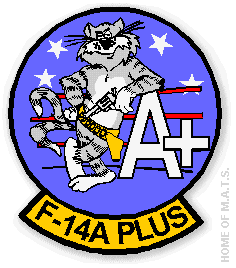
|
The Next Step: F-14B, F-14C, F-14A+ Already in 1973 one F-14A (BuNo 157986) was re-equipped with new engines, the Pratt & Whittney F401-P400 to replace the troublesome TF30 engines. The latter one has always been a problem for the F-14. The F-14B prototype with F401 engines made its maiden flight as early as on 12 September 1973. But tests with the F401 engine were not as satisfying as desired and finally, after completion of a series of test flights, the F-14B was put into long term storage at Bethpage.  The F-14B was taken out of storage again in early 1981 and a pair of General Electric F101DFE (Derivative Fighter Engine) was fitted into it. This time flight tests were more successful and the F-14B prototype was put through a 33 hours flight evaluation. Thereafter, beginning on 14 July 1981, some 22 Grumman and 3 Navy test flights took place, during which engine installation problems arose. Grumman test pilots discovered that the F-14B could accelerate from Mach 0.8 to Mach 1.8 in just 90 seconds and the Navy found out, that the F-14B could launch from a catapult without the use of afterburners. Further, for the first time in the F-14's lifetime, pilot talked of "flying the aircraft and not the engines".
The F-14B was taken out of storage again in early 1981 and a pair of General Electric F101DFE (Derivative Fighter Engine) was fitted into it. This time flight tests were more successful and the F-14B prototype was put through a 33 hours flight evaluation. Thereafter, beginning on 14 July 1981, some 22 Grumman and 3 Navy test flights took place, during which engine installation problems arose. Grumman test pilots discovered that the F-14B could accelerate from Mach 0.8 to Mach 1.8 in just 90 seconds and the Navy found out, that the F-14B could launch from a catapult without the use of afterburners. Further, for the first time in the F-14's lifetime, pilot talked of "flying the aircraft and not the engines".
With its 65,000 lbs of thrust, the F101DFE engines produced enough power to give the F-14 a thrust to weight ratio of almost one to one. That means, the F-14B prototypes were able to accelerate in the vertical, something the F-14A was unable of. But the Navy - not the pilots - decided against the F-14B and the test program was terminated in September 1981. Also in September 1981 Grumman was in the process of building a second F-14B prototype (BuNo 158630) to continue with the engine-upgrade program, but the Navy cancelled the F-14B program and the aircraft - already on the assembly lines - was converted back to F-14A standard. A few years later, in July 1984, Grumman was ordered to take the F-14B prototype out of storage again and install a pair of General Electric F110-GE-400 engines. In July 1984 began flight testing with the new engine and this time the tests proved highly succesful and this led to the F-14A(PLUS) (see below) production. The prototype F-14B (BuNo 157986) was again put into long term storage at Bethpage, NY. A few years ago, the Navy decided to redesignate the F-14A(PLUS) to F-14B. During the F-14B program, studies of an upgraded version - the F-14C - was put into the race powered by two General Electric F101DFE engines. The F-14C should have incorporated upgraded avionics, improved radar plus a fire control system, that is compatible As said already above, testing of the F-14A(PLUS) with the new General Electric F110-GE-400 engine began in July 1984. Grumman was awarded a 863.8 million dollar (fixed price) contract for upgrading the F-14A. While the engines were the most important modification, also a Fatigue Engine Monitoring System, an ARC-182 UHF/VHF radio, an ALR-67 Threat Warning & Recognition System, a Direct Lift Control/Approach Power Control (DLC/AFC MOD), a Hughes AWG-15 radar fire control system as well as a gun gas purge system were part of the upgrade.The first F-14A(PLUS) - Block 145, BuNo 162910 - made its maiden flight in September 1986 and marked the beginning of a six aircraft (including the F-14B prototype BuNo 157986) flight test program. With twice 28,200 lbs of thrust, the F-14A(PLUS) is as well as the F-14B prototype and the F-14D capable of launching from the catapult of an aircraft carrier without the use of afterburners. The F110-GE-400 engines are much more fuel efficient and give the F-14A(PLUS) sixty percent more range, 33 percent more time on station and a 61 percent improvement in rate of climb. But the new engines save not only fuel, they also hide the decklaunch at night since no afterburner is needed to launch from the carrier. Remember that an afterburner flame is visible from some 40 miles away! Production of the F-14A(PLUS) began in March 1987 and on 1 May 1991 all F-14A(PLUS) were redesignated F-14B. |
Top of the page |
F-14 Tomcat History: Photos of early testing and production | Export Tomcats | F-14B: The next step | F-14D: The best ever Grumman proposals for the future | Today & Tomorrow | F-14 Combat Records The last F-14 catshot | The Final F-14 Flight Event F-14 Tomcat: Other Topics: Start Page Foreword FAQ Updates Copyright © by Torsten Anft |